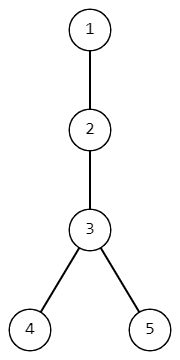CF1843D.Apple Tree
普及/提高-
通过率:0%
AC君温馨提醒
该题目为【codeforces】题库的题目,您提交的代码将被提交至codeforces进行远程评测,并由ACGO抓取测评结果后进行展示。由于远程测评的测评机由其他平台提供,我们无法保证该服务的稳定性,若提交后无反应,请等待一段时间后再进行重试。
题目描述
Timofey has an apple tree growing in his garden; it is a rooted tree of n vertices with the root in vertex 1 (the vertices are numbered from 1 to n ). A tree is a connected graph without loops and multiple edges.
This tree is very unusual — it grows with its root upwards. However, it's quite normal for programmer's trees.
The apple tree is quite young, so only two apples will grow on it. Apples will grow in certain vertices (these vertices may be the same). After the apples grow, Timofey starts shaking the apple tree until the apples fall. Each time Timofey shakes the apple tree, the following happens to each of the apples:
Let the apple now be at vertex u .
- If a vertex u has a child, the apple moves to it (if there are several such vertices, the apple can move to any of them).
- Otherwise, the apple falls from the tree.
It can be shown that after a finite time, both apples will fall from the tree.
Timofey has q assumptions in which vertices apples can grow. He assumes that apples can grow in vertices x and y , and wants to know the number of pairs of vertices ( a , b ) from which apples can fall from the tree, where a — the vertex from which an apple from vertex x will fall, b — the vertex from which an apple from vertex y will fall. Help him do this.
输入格式
The first line contains integer t ( 1≤t≤104 ) — the number of test cases.
The first line of each test case contains integer n ( 2≤n≤2⋅105 ) — the number of vertices in the tree.
Then there are n−1 lines describing the tree. In line i there are two integers ui and vi ( 1≤ui,vi≤n , ui=vi ) — edge in tree.
The next line contains a single integer q ( 1≤q≤2⋅105 ) — the number of Timofey's assumptions.
Each of the next q lines contains two integers xi and yi ( 1≤xi,yi≤n ) — the supposed vertices on which the apples will grow for the assumption i .
It is guaranteed that the sum of n does not exceed 2⋅105 . Similarly, It is guaranteed that the sum of q does not exceed 2⋅105 .
输出格式
For each Timofey's assumption output the number of ordered pairs of vertices from which apples can fall from the tree if the assumption is true on a separate line.
输入输出样例
输入#1
2 5 1 2 3 4 5 3 3 2 4 3 4 5 1 4 4 1 3 3 1 2 1 3 3 1 1 2 3 3 1
输出#1
2 2 1 4 4 1 2
输入#2
2 5 5 1 1 2 2 3 4 3 2 5 5 5 1 5 3 2 5 3 2 1 4 2 3 4 3 2 1 4 2
输出#2
1 2 1 4 2
说明/提示
In the first example:
- For the first assumption, there are two possible pairs of vertices from which apples can fall from the tree: (4,4),(5,4) .
- For the second assumption there are also two pairs: (5,4),(5,5) .
- For the third assumption there is only one pair: (4,4) .
- For the fourth assumption, there are 4 pairs: (4,4),(4,5),(5,4),(5,5) .
 Tree from the first example.For the second example, there are 4 of possible pairs of vertices from which apples can fall: (2,3),(2,2),(3,2),(3,3) . For the second assumption, there is only one possible pair: (2,3) . For the third assumption, there are two pairs: (3,2),(3,3) .
Tree from the first example.For the second example, there are 4 of possible pairs of vertices from which apples can fall: (2,3),(2,2),(3,2),(3,3) . For the second assumption, there is only one possible pair: (2,3) . For the third assumption, there are two pairs: (3,2),(3,3) .